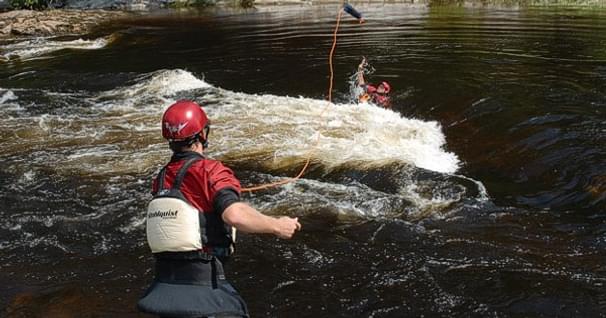The Art of Lining a Canoe
Picture yourself approaching a set of rapids, with only a faint out-of-the-way animal trail heading up a steep incline as a portage. To make matters worse, the white water ahead is clogged with sharp pieces of granite, is rated at least a Class III, and has a couple of dangerous ledges. Making a safe run, especially in such a far-off setting, becomes questionable, even for the die-hard fanatic. So it's obvious that the best option is to tie your canoe and cargo on a short leash and walk it down like a pet dog.
This maneuver sounds a bit insane at first, but lining a canoe is an art form that has been practiced for years. It shouldn't be taken lightly. However, after many years of trial and error on less remote trips this technique can help transform a river thought to be un-navigable into a trip of a life time.
First you must choose between lining with one or two ropes. Lining with two ropes attached to bow and stern takes a little more rehearsing than just having one tied on to the stern. However, it also gives you more control of the boat as it surges downstream.
To attach your two lengths of nylon rope (27 yards/25 meters long and 1/4 inch/6mm thick) some canoeists simply tie each piece to the bow and stern base plate. This limits your control over the canoe, however. The rope is much more efficient lower to the water. You could drill holes through the upper ends of the bow and stern and place the rope through there. But I find the bridle knot (perfected by the legendary canoeist, Bill Mason) to be the best bet. Take a length of your rope and double back one end approximately two yards (two meters). Then knot both ends together in the center. Now place the two short ends of rope under the bow, so the knot is positioned under the canoe, right on the centerline, and tie the ends to the outer portions of the canoe seat. Repeat the same procedure with the other length of tracking line at the stern. With the main length of rope positioned directly under the canoe you place the point of pull on the centerline; this prevents the canoe from tipping when you're pulling it across the current.
~Get the BWCAW Tee~
With over 1,090,000 acres of wilderness area, the BWCAW is a paddler's paradise.
It is up to you whether to track the canoe downstream alone or with the help of partner. Choosing to go alone means you're going to have to adjust both ropes. This can be confusing at the best of times. But with a partner taking one end and you on the other, communication and coordination becomes essential. I've seen far too many arguments erupt from partners trying to line together. I choose to go at it alone.
Lining solo you must adjust the two lengths of rope and regulate the angle of the canoe relative to the current. The force of the water will push against the canoe, skirting it back and forth and allowing you to place it in the desired position.
Having the stern pointed upstream and the packs weighing down the bow will give you more maneuverability and lessens the chance of the canoe digging into the water and swamping. Also try to avoid eddies where the canoe is forced upstream with the current; it may swing broadside when forced back into the mainstream and yank you into the drink. Also make sure not to get tangled in the rope. You can drown in an instant this way, which is why all canoeists should always have a sharp belt knife on them or a sheathed blade attached to your PFD.
Remember that lining is an art form, a technique where finesse and coordination beats out brute strength every step of the way.
Kevin Callan is the author of eight books including 'The Happy Camper: An Essential Guide to Life Outdoors'. He is a recipient of the National Magazine Award and a regularly featured speaker at North America's largest paddling events. Check out Kevin's web site: kevincallan.com
Related Articles
Casting out a rescue throw line, either contained within a Throw Bag or gathered in coils requires…
One of the most critical, and versatile pieces of kayaking gear is a workable length of line. Most…
One of the lowest-risk and most effective techniques for reaching a victim is by use of a throw rope. In…
I absolutely love the scene in Bill Mason's Waterwalker film where he lines his canoe down a…




